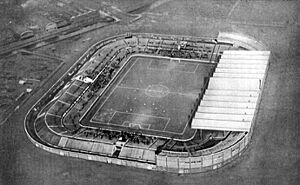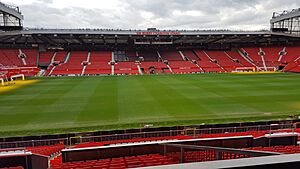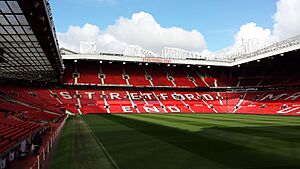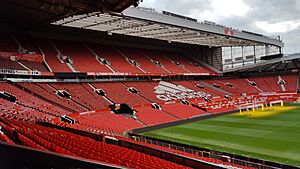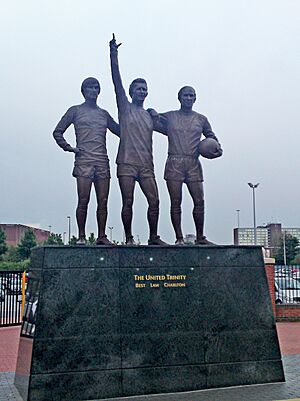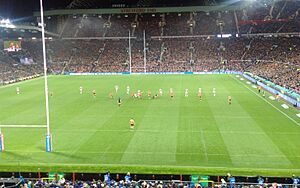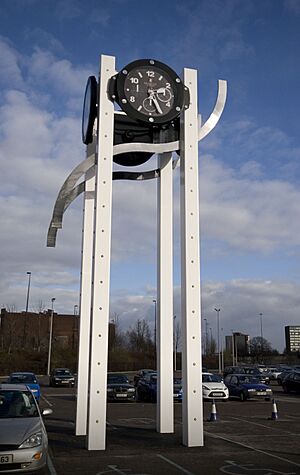Old Trafford facts for kids
|
"The Theatre of Dreams"
|
|

|
|
| Address | Sir Matt Busby Way |
|---|---|
| Location | Old Trafford Greater Manchester, England M16 0RA |
| Public transit | |
| Owner | Manchester United |
| Operator | Manchester United |
| Capacity | 74,197 |
| Record attendance | 76,962 (Wolverhampton Wanderers vs Grimsby Town, 25 March 1939) |
| Field size | 105 by 68 metres (114.8 yd × 74.4 yd) |
| Surface | Desso GrassMaster |
| Construction | |
| Broke ground | 1909 |
| Opened | 19 February 1910 |
| Renovated | 1941, 1946–1949, 1951, 1957, 1973, 1995–1996, 2000, 2006 |
| Construction cost | £90,000 (1909) |
| Architect | Archibald Leitch (1909) |
| Tenants | |
| Manchester United (1910–present) | |
Old Trafford is a famous football stadium in Old Trafford, Greater Manchester, England. It is the home ground for the football club Manchester United.
With space for 74,197 fans, it is the largest club football stadium in the United Kingdom. It is also the second-largest football stadium overall in the UK, after Wembley Stadium. In Europe, it ranks as the eleventh-largest stadium.
The stadium is often called "The Theatre of Dreams," a nickname given by legendary player Bobby Charlton. Manchester United has played here since 1910. However, during World War II, the stadium was damaged by bombs. The club had to share Maine Road with rivals Manchester City from 1941 to 1949.
Old Trafford has been expanded many times, especially in the 1990s and 2000s. These changes added more seating to different stands. The stadium almost reached its original capacity of 80,000. The highest number of people ever at Old Trafford was 76,962 in 1939. This was for an FA Cup semi-final match.
Besides club games, Old Trafford has hosted many important football events. These include an FA Cup Final, matches for the 1966 FIFA World Cup, UEFA Euro 1996, and the 2012 Summer Olympics. It also hosted the 2003 UEFA Champions League Final. The stadium is also used for rugby league, hosting the annual Super League Grand Final since 1987.
Contents
History of Old Trafford Stadium
Building the Dream: Early Years
Before 1902, Manchester United was known as Newton Heath. They played at grounds like North Road and Bank Street. These places often had poor pitches and factory fumes. In 1909, the new chairman, John Henry Davies, decided the team needed a better home. He used his own money to build a new stadium.
Davies chose a spot next to the Bridgewater Canal in Old Trafford. Scottish architect Archibald Leitch designed the stadium. He had designed many other sports grounds. The original plan was for 100,000 spectators. However, the cost grew, so the capacity was reduced to about 80,000. Even so, the £90,000 cost was huge for the time. This led to the club being called "Moneybags United."
The stadium officially opened on 19 February 1910. Manchester United played against Liverpool, but lost 4–3. A journalist at the time called it "the most remarkable arena I have ever seen." He said it was "unrivalled in the world."
Old Trafford hosted two FA Cup Finals before Wembley Stadium was built. The first was in 1911, a replay between Bradford City and Newcastle United. Bradford won 1–0 in front of 58,000 fans. The second was the 1915 final between Sheffield United and Chelsea. Sheffield United won 3–0. Many of the 50,000 spectators were soldiers, so it was called "the Khaki Cup Final."
On 25 March 1939, Old Trafford saw its highest ever attendance. A massive 76,962 people watched an FA Cup semi-final. This match was between Wolverhampton Wanderers and Grimsby Town.
Rebuilding After Wartime Damage
In the 1930s, roofs were added to parts of the stadium. But during World War II, Old Trafford was used by the military. German bombing raids in 1940 and 1941 severely damaged the stadium. The main stand was destroyed.
Manchester United had to play their home games at Maine Road. This was the stadium of their rivals, Manchester City. The club received some money to rebuild, but it was a tough time. Old Trafford finally reopened in 1949, almost 10 years after the last league game there. The first match back was a 3–0 win against Bolton Wanderers.
Modernizing for Better Views
By 1959, all the stands had roofs again. New floodlights were installed in 1957. This allowed evening games, especially for European competitions. To prevent shadows, parts of the main stand roof were cut away.
In 1965, the North Stand was redesigned. Old pillars that blocked views were replaced with modern cantilever roofs. These roofs hang over the stands without supports in front. This meant every fan had a clear view. The East Stand was updated in the same way in 1973. The club planned to make all four stands like this, creating a "bowl-like" stadium. This design helps keep crowd noise inside, making the atmosphere more exciting.
Becoming an All-Seater Stadium
Over the years, the stadium's capacity slowly decreased. By the 1980s, it held about 60,000 fans. In 1990, a new rule called the Taylor Report required all top-division stadiums to have only seats. This meant removing all standing areas. This change cost a lot of money and reduced Old Trafford's capacity to about 44,000.
Manchester United's success in the 1990s meant more fans wanted to watch. So, the stadium needed to grow again. In 1995, the old North Stand was replaced with a new three-tiered stand. This new stand, designed by Atherden Fuller, could hold about 25,500 people. It increased the stadium's total capacity to over 55,000. Its cantilever roof was the largest in Europe at the time.
More expansions followed. A second tier was added to the East Stand in 2000. Then, another 7,000 seats were added to the West Stand. This brought the capacity to 68,217, making it the biggest club stadium in the UK. In 2003, Old Trafford hosted its first major European final, the 2003 UEFA Champions League Final.
From 2001 to 2007, while Wembley Stadium was being rebuilt, Old Trafford hosted many England matches. It held 14 of England's 34 home games during that period.
Recent Expansions and Milestones
The most recent big expansion happened between 2005 and 2006. Second tiers were added to the north-west and north-east corners. This added about 8,000 seats. On 31 March 2007, a new Premier League record attendance was set. A total of 76,098 fans watched United beat Blackburn Rovers.
Old Trafford celebrated its 100th birthday on 19 February 2010. The club held special events, including an art competition for local students. An exhibition about the stadium's history opened at the club museum. A time capsule filled with Manchester United items was buried near the central tunnel.
The stadium was also a venue for the football competition at the 2012 Summer Olympics. It hosted several men's and women's matches. In 2021, the Manchester United women's team played their first game at Old Trafford. In 2022, a record 68,871 fans watched the opening match of UEFA Women's Euro 2022 there.
Stadium Layout and Features
Old Trafford has four main stands, each with a roof and only seats. They are the Sir Alex Ferguson (North), East, Sir Bobby Charlton (South), and West Stands. Most stands have at least two levels. The Sir Bobby Charlton Stand has only one level due to building limits.
Sir Alex Ferguson Stand
This stand used to be called the North Stand. It is the tallest, with three levels, and can hold about 26,000 fans. It also has special executive boxes for guests. This stand was rebuilt in 1996.
Inside, you'll find the Red Café, a Manchester United-themed restaurant. It also houses the Manchester United museum and trophy room. The museum first opened in 1986 and moved to this stand in 1998. It attracts hundreds of thousands of visitors each year.
On 5 November 2011, the North Stand was renamed the Sir Alex Ferguson Stand. This was to honor Alex Ferguson's 25 years as the club's manager. A large statue of Sir Alex Ferguson was placed outside the stand in 2012.
Sir Bobby Charlton Stand
This stand is across from the Sir Alex Ferguson Stand. It was once the main stand and is still where most VIPs sit. Media members also sit here for the best view of the game. The television cameras are usually focused away from this stand.
The team dugouts are in the middle of this stand. They are raised so managers can see the game clearly. The old players' tunnel, used until 1993, is also here. This tunnel is the only part of the original 1910 stadium that survived the wartime bombing. In 2008, it was renamed the Munich Tunnel. This was to remember the 50th anniversary of the Munich air disaster. The new tunnel is in the South-West corner.
On 3 April 2016, this stand was renamed the Sir Bobby Charlton Stand. This honored Bobby Charlton, a legendary Manchester United player.
West Stand (Stretford End)
The West Stand is famously known as the Stretford End. This is where many of Manchester United's most passionate and vocal fans sit. It was the last stand to be fully covered and converted to all-seating in the early 1990s.
When a second level was added in 2000, many long-time fans moved there. They often hang banners and flags. Denis Law, another club legend, was known as the "King of the Stretford End." There is now a statue of him on the stand's upper level.
East Stand
The East Stand is sometimes called the Scoreboard End. It was the second stand to get a cantilever roof. It holds almost 12,000 fans. This stand includes sections for disabled fans and for visiting team supporters.
The club's main offices are behind the tinted glass front of the East Stand. These offices house the staff for the official club magazine and website. Images and advertisements are often displayed on the stand's exterior.
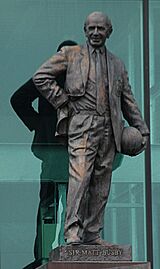
Above the club shop is a statue of Sir Matt Busby, a famous former manager. A plaque honoring the victims of the Munich air disaster is also on this stand. The Munich Clock, which marks the time of the disaster, is at the corner of the East and South Stands. In 2008, a statue called "The United Trinity" was unveiled. It features George Best, Denis Law, and Bobby Charlton.
The Manchester United club shop, or "megastore," is located on the ground floor of the East Stand. It's a large store where fans can buy club merchandise.
Pitch and Surroundings
The pitch itself is about 105 meters long and 68 meters wide. It has an underground heating system with many miles of plastic pipes. This helps keep the grass in good condition, especially in winter. The grass is watered regularly and mowed several times a week.
Near the stadium, there's a 10-meter-tall clock tower. It features four large clock faces. On the east side of the stadium, across the canal, is Hotel Football. This hotel is themed around football and was created by former Manchester United captain Gary Neville. It opened in 2015 and can host many supporters.
Future Plans for Old Trafford
There have been ongoing discussions about further expanding Old Trafford. The next likely step would be to redevelop the Sir Bobby Charlton Stand. If a second tier were added, similar to the Sir Alex Ferguson Stand, the stadium's capacity could reach around 80,000. If the corner stands were also expanded, the capacity could go up to 88,000.
Building over the nearby railway line and purchasing houses would make this expansion costly. However, club officials have confirmed that expansion plans are being considered.
In 2018, it was reported that these plans were on hold due to practical challenges. The work would be a multi-season project. It would require heavy machinery in areas usually used by fans. Also, the Sir Bobby Charlton Stand holds important facilities like changing rooms and TV studios. The club's managing director mentioned that such a big project might mean Manchester United would have to play elsewhere for a while. Finding another suitable stadium nearby is difficult.
In 2021, the club's co-chairman, Joel Glazer, confirmed that "early-stage planning work" for Old Trafford's redevelopment was underway. This followed concerns about the lack of updates since 2006. One idea being considered is building an entirely new stadium on the same site. In 2024, it was reported that Sir Jim Ratcliffe, a part-owner of Manchester United, wants to build a "Wembley of the North" on the site. On 11 March 2025, Manchester United confirmed plans for a new 100,000-seat stadium. This new stadium, called New Trafford, would be part of a larger redevelopment of the area.
Other Events at Old Trafford
Old Trafford is not just for football. It has hosted both rugby league and rugby union matches.
Rugby League Matches
Old Trafford has hosted every Super League Grand Final since 1998. The first rugby league match here was in 1958. In 1986, it hosted its first international rugby league Test match. Australia beat Great Britain in front of over 50,000 fans.
The stadium also hosted the final of the 2000 Rugby League World Cup. Australia won against New Zealand. In 2013, Old Trafford hosted the 2013 Rugby League World Cup final. Australia again won, this time against New Zealand, with a record crowd of 74,468. In January 2019, Old Trafford was chosen to host the men's and women's finals of the 2021 Rugby League World Cup.
Rugby Union Matches
The first rugby union match at Old Trafford was in 1924. A local team played against the New Zealand national team. In 1997, New Zealand played against England in an international match here. England also played Argentina at Old Trafford in 2009. The stadium was considered for the 2015 Rugby World Cup, but Manchester United later withdrew.
Other Sports and Events
Before the football stadium, the site was used for shinty, a Scottish game. During World War I, American soldiers played baseball here. In 1927, a tennis exhibition match was held. Over 15,000 people watched French champion Suzanne Lenglen play. In 1981, a cricket competition was played under floodlights. In 1993, a major boxing match between Chris Eubank and Nigel Benn drew about 42,000 fans.
Old Trafford has also hosted concerts by famous musicians like Bon Jovi and Bruce Springsteen. It is also used for private events like weddings and business meetings.
Stadium Records
The highest attendance ever at Old Trafford was 76,962. This was for an FA Cup semi-final on 25 March 1939. However, this was before the stadium had only seats. The record attendance for an all-seater game is 76,098. This was for a Premier League match between Manchester United and Blackburn Rovers on 31 March 2007.
The lowest attendance for a competitive game after World War II was 11,968 in 1950. The highest average attendance for a league season was 75,826 in 2006–07. The lowest average attendance was 11,685 in the 1930–31 season.
Getting to Old Trafford
The Manchester United Football Ground railway station is right next to the stadium. It used to serve fans on matchdays.
The stadium is also served by the Manchester Metrolink tram network. The closest tram stops are Wharfside, Old Trafford, and Exchange Quay. All three are less than a 10-minute walk away.
Several bus routes also stop near Old Trafford. Buses 255, 256, and 263 run from Piccadilly Gardens to Chester Road. The 250 and X50 services stop on Wharfside Way and Water's Reach. There are also special matchday buses. Old Trafford has several car parks that are free on non-matchdays.
See also
 In Spanish: Old Trafford para niños
In Spanish: Old Trafford para niños


